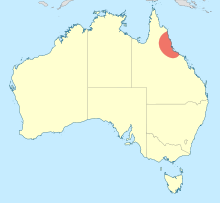Pseudocordulia elliptica
Pseudocordulia elliptica is a species of dragonfly in the family Pseudocorduliidae,[3] known as the ellipse-tipped mistfly.[4] It is a medium-sized, bronze-black dragonfly with clear wings.[4] It is endemic to north-eastern Queensland, Australia,[5] where it inhabits rainforest streams.[6]
| Ellipse-tipped mistfly | |
|---|---|
| Scientific classification | |
| Kingdom: | Animalia |
| Phylum: | Arthropoda |
| Class: | Insecta |
| Order: | Odonata |
| Infraorder: | Anisoptera |
| Family: | Pseudocorduliidae |
| Genus: | Pseudocordulia |
| Species: | P. elliptica |
| Binomial name | |
| Pseudocordulia elliptica | |
 | |
Gallery
.jpg) Female wings
Female wings.jpg) Male wings
Male wings
Note
There is uncertainty about which family Pseudocordulia elliptica best belongs to: Pseudocorduliidae,[3] Synthemistidae,[7] or Corduliidae.[8]
gollark: Would *you* like several PMs a day begging, cajoling or harassing you?
gollark: I mean, it might be lots of people, in a harassing fashion.
gollark: <@480213740499894283> It might actually be due to a "value ceiling" sort of thing - there's not really anything rarer than a Neglected which is available to the wider DC community - so they can't really ask for anything but several neglecteds.
gollark: Yes, that is indeed true.
gollark: They're certainly fairer than prizes!
See also
References
| Wikimedia Commons has media related to Pseudocordulia elliptica. |
- Dow, R.A. (2017). "Pseudocordulia elliptica". IUCN Red List of Threatened Species. 2017: e.T87539751A87540209. doi:10.2305/IUCN.UK.2017-1.RLTS.T87539751A87540209.en.
- Tillyard, R.J. (1913). "Some descriptions of new forms of Australian Odonata". Proceedings of the Linnean Society of New South Wales. 38: 229–241 [229] – via Biodiversity Heritage Library.
- "Species Pseudocordulia elliptica Tillyard, 1913". Australian Faunal Directory. Australian Biological Resources Study. 2012. Retrieved 30 March 2017.
- Theischinger, Günther; Hawking, John (2006). The Complete Field Guide to Dragonflies of Australia. Collingwood, Victoria, Australia: CSIRO Publishing. p. 222. ISBN 978 0 64309 073 6.
- Watson, J.A.L.; Theischinger, G.; Abbey, H.M. (1991). The Australian Dragonflies: A Guide to the Identification, Distributions and Habitats of Australian Odonata. Melbourne: CSIRO. ISBN 0643051368.
- Theischinger, Gunther; Endersby, Ian (2009). Identification Guide to the Australian Odonata (PDF). Department of Environment, Climate Change and Water NSW. p. 235. ISBN 978 1 74232 475 3.
- Schorr, Martin; Paulson, Dennis. "World Odonata List". Slater Museum of Natural History. University of Puget Sound. Retrieved 30 March 2017.
- "Pseudocordulia". Wikispecies. 2006. Retrieved 30 March 2017.
This article is issued from Wikipedia. The text is licensed under Creative Commons - Attribution - Sharealike. Additional terms may apply for the media files.
